PERENNIALS > EUPHORBIA > VARIETIES

Elizabeth is a Permaculture Garden Designer, Sustainability Consultant and Professional Writer, working as an advocate for positive change. She graduated from the University of St. Andrews with an MA in English and Philosophy and obtained a Diploma in Applied Permaculture Design from the Permaculture Association.
Reviewed By DAN ORI

Dan has over 27 years’ under his belt caring for plants and gardens. Working as a Horticultural Instructor and Consultant, he draws on a diverse range of experience that includes working as a Head Gardener, Tree Surgeon, Garden Centre Trouble Shooter, and writer of academic papers. Dan has a Level 3 Diploma in Horticulture and is currently a candidate for the RHS’s most prestigious award – The Master of Horticulture.
Contributions From DARREN EVANS

Darren is the Plant Manager at Pugh's Cacti, a wholesale supplier of cactus and succulent plants to garden centres in the UK, based in Worcestershire.

Tom Simpson is an award-winning Garden Designer and the first person to ever win all four awards at the Hampton Court Palace Garden Festival for his garden in 2021. He trained at the London School of Garden Design based at Kew Botanic Gardens and has worked as a Designer at Rosebank Landscaping for more than 6 years.
IN THIS GUIDE
EUPHORBIA GUIDES
Propagation
Pruning
Varieties
Euphorbias are generally divided into those that are suitable for outdoor cultivation in the UK and those that are commonly grown as houseplants or in greenhouses in our climate.
These are very varied plants, and though they share a genus, they can differ greatly in their appearance, growth habits and needs.
One of the first things that you will have to decide when choosing a Euphorbia to grow is where you will be growing it.

Even among Euphorbias that can be grown outside, there are many differences in the environmental conditions that different species and cultivars within this genus prefer.
Some do best in full sun and free-draining conditions, while others will do best in consistently moist soil positioned in partial shade.
Another important thing to think about is the size to which a particular species and cultivar of Euphorbia will grow, as they can differ greatly in this respect too.
Some are larger herbaceous perennials or shrubs, whilst some are low-growing ground cover plants.

“A great Euphorbia to try is Euphorbia obesa,” says Darren Evans from Pugh’s Cacti.
“It grows slowly and produces a dome shape that flowers along its ribs.

“Euphorbia eritrea is another variety to try. It grows fast and can reach 15 feet in height, as it does in our nursery.”
Linked with the size of a Euphorbia are its growth habits and the general details of its appearance.
In these respects too Euphorbia can be an incredibly diverse group.
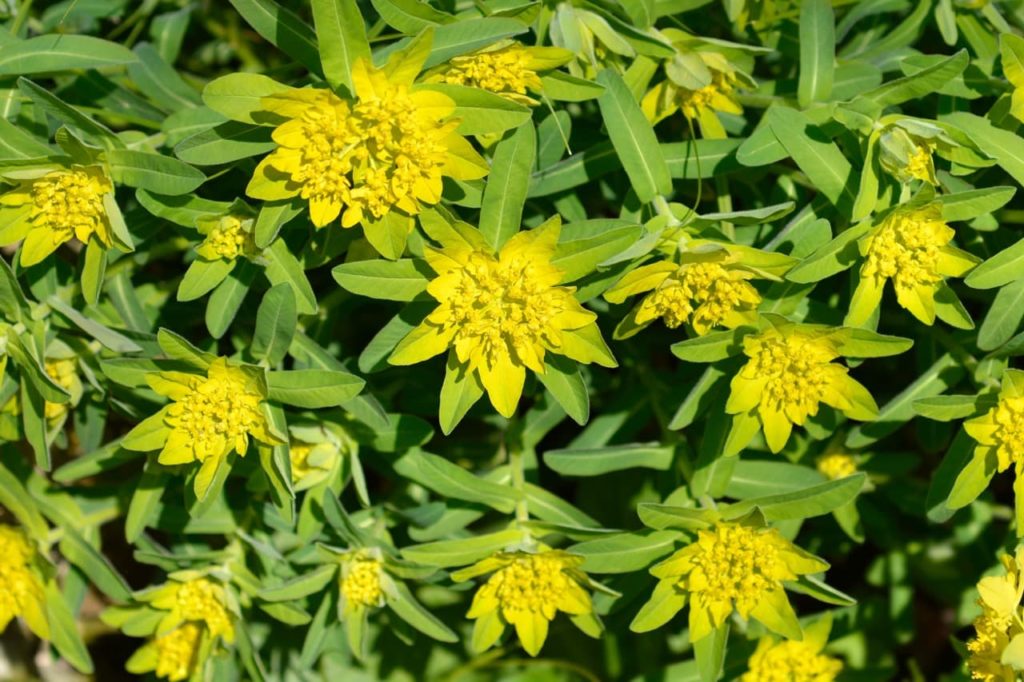
With all that said, here are some of my favourite varied euphorbias that might be considered by gardeners in the UK.
1) E. amygdaloides var. robbiae
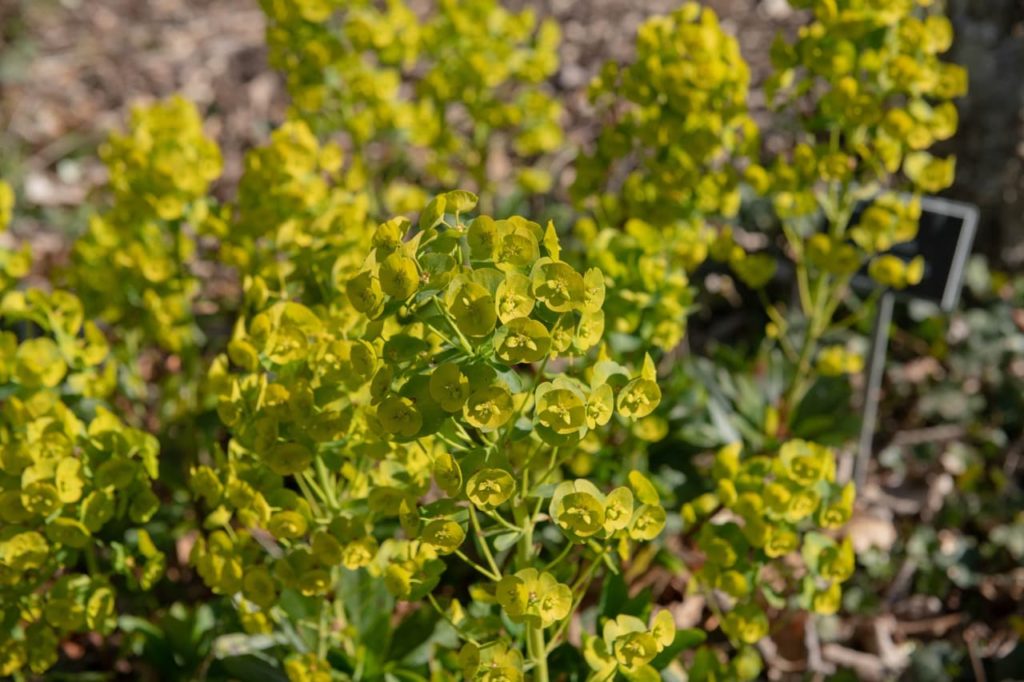
- COMMON NAME(S): Mrs Robb’s bonnet
- HARDINESS RATING: H6
- FOLIAGE: evergreen
- FLOWERING SEASON(S): spring / summer
- SUNLIGHT: any
- SOIL REQUIREMENTS: loam, sand, clay; any pH
- SIZE: 0.1-0.5m in height, 1-1.5m spread
Also known as Mrs Robb’s Bonnet, this Euphorbia is a perennial evergreen that grows to around 50cm tall.
It forms rosettes of deep green leaves and bears large, rounded sprays of yellowy-green flowers in the spring and summer.
“We always use plants like E. amygdaloides var. robbiae that are great for filling in spots under trees,” shares Garden Designer Tom Simpson.
This is a good choice for areas of dry shade, though it can also grow in partial shade or full sun.
It will do best in moist but well-drained or well-drained soil.
2) E. characias

- COMMON NAME(S): Mediterranean spurge
- HARDINESS RATING: H4
- FOLIAGE: evergreen
- FLOWERING SEASON(S): winter / spring
- SUNLIGHT: full sun
- SOIL REQUIREMENTS: loam, sand, clay; any pH
- SIZE: 1-1.5m in height, 1-1.5m spread
Mediterranean spurge is a great plant for pollinators.
It is a perennial that is evergreen and grows to around 1.5m tall.
It has biennial stems, which are leafy in their first year and flowers in their second, becoming bare over the lower part of the stem.
The flowers are prolific, borne in the spring in large cylindrical heads made up of petal-like bracts around tiny bright yellowy-green flowers.
This is a short-lived perennial that often self-seeds when placed in the right location.
Grow in well-drained soil in full sun in a sheltered spot.
3) E. cornigera

- COMMON NAME(S): horned spurge
- HARDINESS RATING: H5
- FOLIAGE: deciduous
- FLOWERING SEASON(S): summer
- SUNLIGHT: full sun / part shade
- SOIL REQUIREMENTS: loam, sand, clay; any pH
- SIZE: 0.5-1m in height, 0.5-1m spread
Horned spurge has an RHS Award of Garden Merit and is another good choice for a pollinator-friendly garden.
This is a spreading perennial which grows around 75cm tall.
It has slightly reddish stems with dark green leaves and bears bright yellow flowers in the summer.
This Euphorbia is best grown in full sun or part shade, in moist but well-drained soil.
4) E. griffithii

- COMMON NAME(S): Griffith’s spurge
- HARDINESS RATING: H7
- FOLIAGE: deciduous
- FLOWERING SEASON(S): summer
- SUNLIGHT: part shade
- SOIL REQUIREMENTS: clay or loam; any pH
- SIZE: 0.5-1m in height, 0.5-1m spread
Griffith’s spurge is a vigorous perennial with a spreading habit which can have a height and spread of up to 1m or so.
It has lanceolate leaves which turn red and yellow in the autumn months and bears clusters of red, orange or yellow flowers at the beginning of summer.
This is a Euphorbia that does best in part shade in moist yet free-draining soil.
It will tend to do best in clay or loam soil, with an east or west-facing aspect.
It is H7 hardy and is among the hardiest plants to grow, coping even in the coldest regions in extreme winter temperatures.
“I find E. griffithii one of the best garden Euphorbias due to its hardiness and autumn colour,” shares Master Horticulturist Dan Ori.
“I recommend planting it in a border with other plants that give red and yellow autumn colour like Acers and also try mixing in dark green-leaved evergreens with plants like Aucuba japonica ‘Rozannie’.”
5) E. hypericifolia
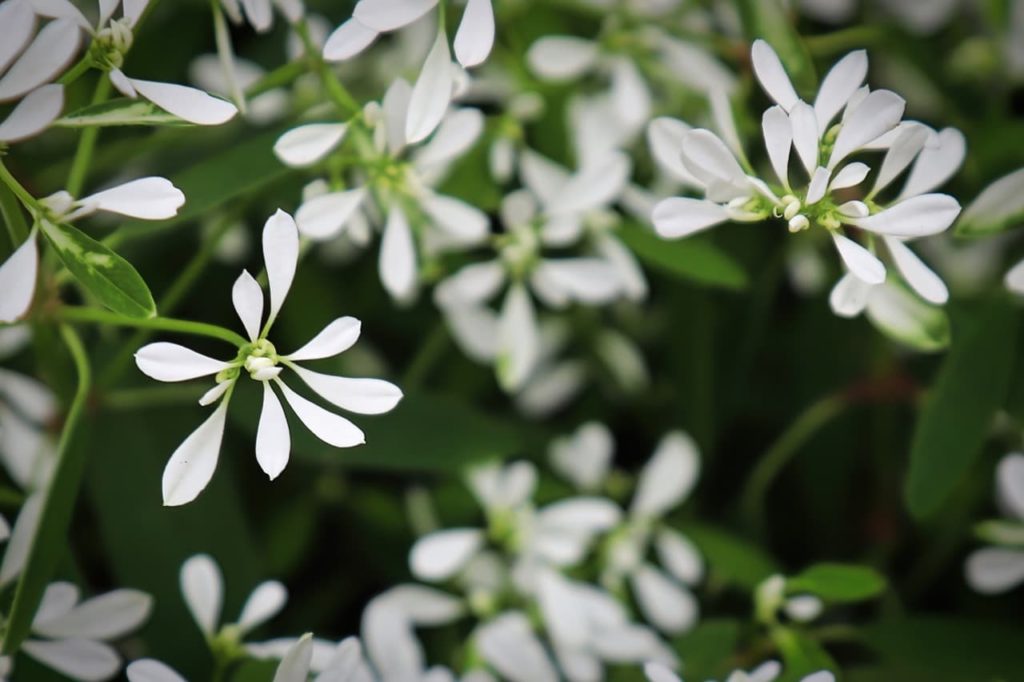
- HARDINESS RATING: H2
- FOLIAGE: evergreen
- FLOWERING SEASON(S): spring / summer / autumn
- SUNLIGHT: full sun / part shade
- SOIL REQUIREMENTS: sand, loam, clay; any pH
- SIZE: 0.1-0.5m in height, 0.1-0.5m spread
This is a tender Euphorbia that is best grown undercover indoors or in a greenhouse.
It can also be placed outdoors in a mild, sheltered and sunny position with light, free-draining conditions.
It is a good choice for hanging baskets or a container garden.
This is a small evergreen perennial, with tiny dark green leaves and tiny white flowers which are borne from spring to autumn.
However, this plant is only H2 hardy and won’t survive outdoors year-round.
6) E. ingens
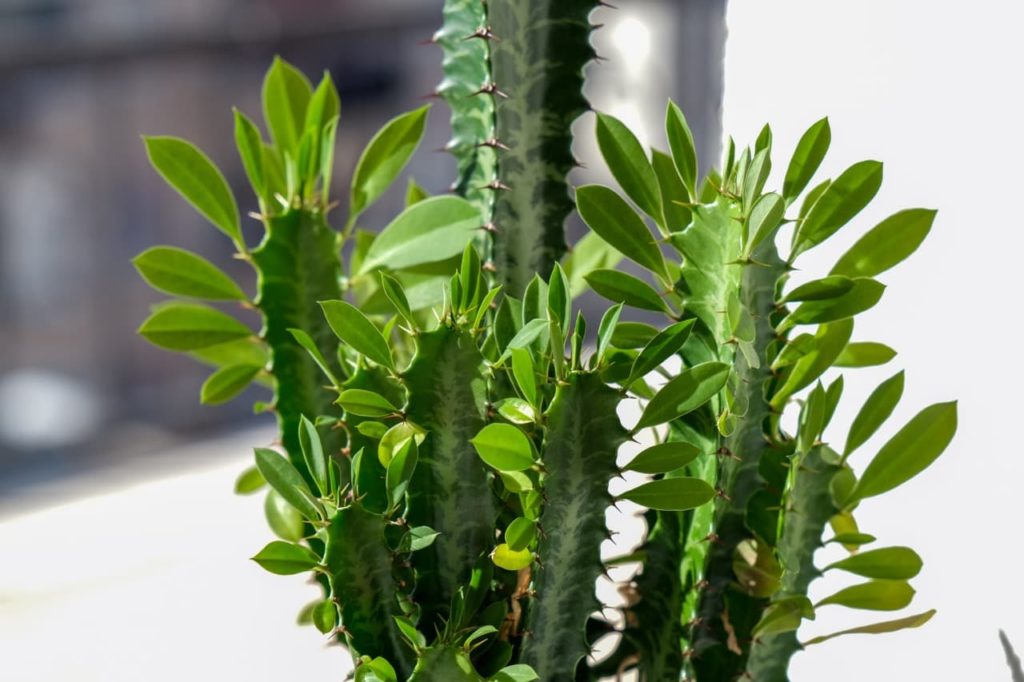
- COMMON NAME(S): candelabra tree
- HARDINESS RATING: H2
- FOLIAGE: evergreen
- FLOWERING SEASON(S): autumn / winter
- SUNLIGHT: full sun
- SOIL REQUIREMENTS: sand or clay; any pH
- SIZE: 12m in height, 8m spread
Though it can grow to around 15m in height when fully grown, these cacti-like succulent plants are commonly much smaller and are commonly grown in containers.
Ridged and with spines along their broad succulent stems, they can, when mature, produce greenish-yellow flowers followed by reddish or purple fruits.
Requiring a free-draining and sheltered position in full sun, this Euphorbia is H2 hardy.
It is usually grown as a houseplant indoors.
“My E. ingens takes over a significant part of my greenhouse as the spines make it too hazardous for the house,” shares Dan.
“It handles low temperatures well but does not like cold and damp conditions.”
7) E. lathyris
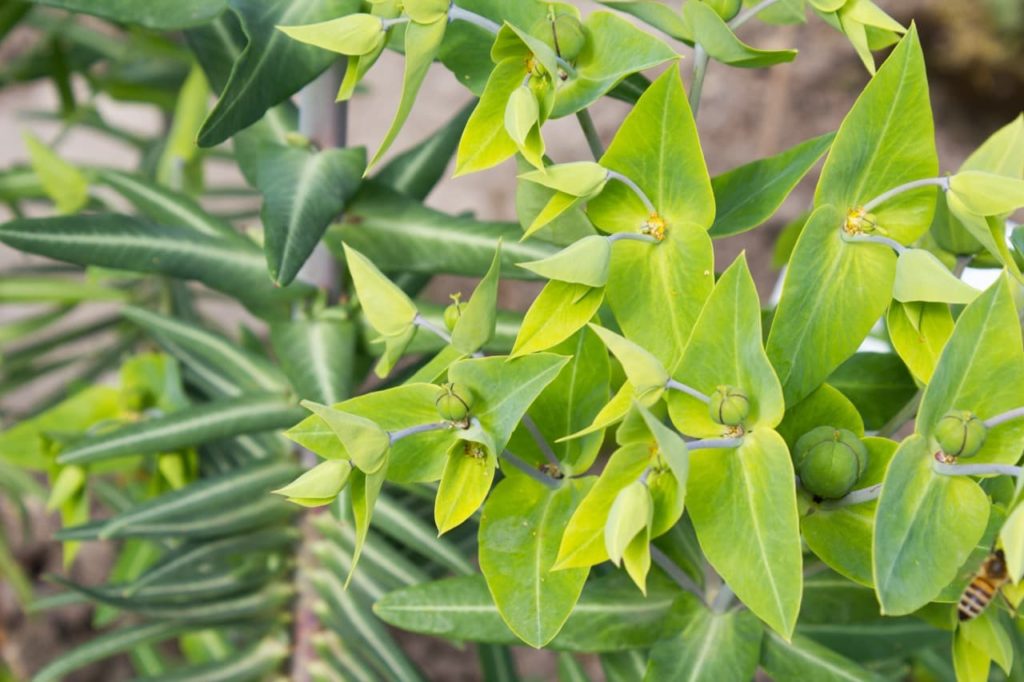
- COMMON NAME(S): caper spurge
- HARDINESS RATING: H5
- FOLIAGE: evergreen
- FLOWERING SEASON(S): spring / summer
- SUNLIGHT: full sun / part shade
- SOIL REQUIREMENTS: chalk, sand, clay; any pH
- SIZE: 1-1.5m in height, 0.1-0.5m spread
Also sometimes referred to as E. crucifolia and commonly known as caper spurge; this is an annual or biennial Euphorbia species.
It will typically reach around 1.2m in height.
Its leaves are around 15cm long and they extend directly sideways out of unbranched stems.
In late spring and early summer, these plants have small yellow-green blooms that are followed by triple seed heads that turn brown as they mature.
This Euphorbia likes moist but well-drained or well-drained soil in full sun or partial shade.
8) E. mellifera

- COMMON NAME(S): honey spurge
- HARDINESS RATING: H3
- FOLIAGE: semi-evergreen
- FLOWERING SEASON(S): spring
- SUNLIGHT: full sun / part shade
- SOIL REQUIREMENTS: loam, sand, clay; any pH
- SIZE: 1.5-2m in height, 2-2.5m spread
E. mellifera is another more tender Euphorbia that can be grown outdoors in some locations in summer but usually requires an indoors or undercover, frost-free spot in winter.
It is a domed shrub with bright green lance-like leaves with paler veins down their centres and brownish flower heads which are borne in the late spring.
This option requires well-drained soil in a sheltered location in full sun.
It is H3 hardy so may be grown outdoors year-round only in the mildest, coastal locations in the south of the British Isles.
9) E. milii

- COMMON NAME(S): crown of thorns
- HARDINESS RATING: H1B
- FOLIAGE: evergreen
- FLOWERING SEASON(S): summer
- SUNLIGHT: full sun
- SOIL REQUIREMENTS: loam, sand, clay; any pH
- SIZE: 0.5-1m in height, 0.1-0.5m spread
This Euphorbia, often also referred to as Crown of thorns, Christ plant, or Christ thorn, is a large evergreen plant with leathery oval leaves and clusters of small yellow flowers with vibrant bright red bracts.
It requires well-drained conditions in full sun and is most commonly grown indoors or in a greenhouse year-round, though it may also be placed out into a sheltered position in a garden in summer.
The hardiness rating for this Euphorbia is H1B.
10) E. myrsinites

- COMMON NAME(S): broad-leaved glaucous spurge
- HARDINESS RATING: H5
- FOLIAGE: evergreen
- FLOWERING SEASON(S): spring
- SUNLIGHT: full sun
- SOIL REQUIREMENTS: all soil types; any pH
- SIZE: 0-0.1m in height, 0.1-0.5m spread
Also known as broad-leafed glaucous spurge, this Euphorbia is an evergreen perennial which has trailing leafy stems with bright green leaves and, in spring, yellow-green flower clusters that are 10cm across.
This ground cover plant grows only around 10cm tall but can spread over 40-50cm wide.
Grow this plant in full sun in well-drained soil.
It can cope with a sheltered or exposed location and is H5 hardy.
11) E. oblongata

- COMMON NAME(S): Balkan spurge
- HARDINESS RATING: H5
- FOLIAGE: deciduous
- FLOWERING SEASON(S): spring / summer / autumn
- SUNLIGHT: part shade
- SOIL REQUIREMENTS: chalk or sand; any pH
- SIZE: 0.5-1m in height, 0.1-0.5m spread
Balkan spurge is a clump-forming herbaceous plant with dark green stems, which turn red in autumn, and flat heads of yellow flowers that are 15cm wide and bloom over a long period between spring and autumn.
This Euphorbia is best placed in a dappled shade somewhere it will receive sun for part of the day.
Though it is perennial, it is most commonly grown as an annual and will readily self-seed in moist but well-drained, humus-rich soil where it is happy.
So, you might see this plant popping up in your garden year after year.
12) E. palustris

- COMMON NAME(S): marsh spurge
- HARDINESS RATING: H7
- FOLIAGE: deciduous
- FLOWERING SEASON(S): spring
- SUNLIGHT: full sun
- SOIL REQUIREMENTS: clay or loam; any pH
- SIZE: 0.5-1m in height, 0.5-1m spread
E. palustris, also known as marsh spurge, is a herbaceous perennial which will grow up to around 90cm tall.
It has vibrant mid-green leaves which often turn yellow or orange in autumn and bears terminal clusters of greenish-yellow blooms in the late spring.
As the name suggests, this is an unusual Euphorbia in that it will do best not in free-draining conditions like so many of this genus, but instead will thrive in permanently moist soil.
It will thrive in clay or loam in full sun and is H7 hardy.
13) E. schillingii
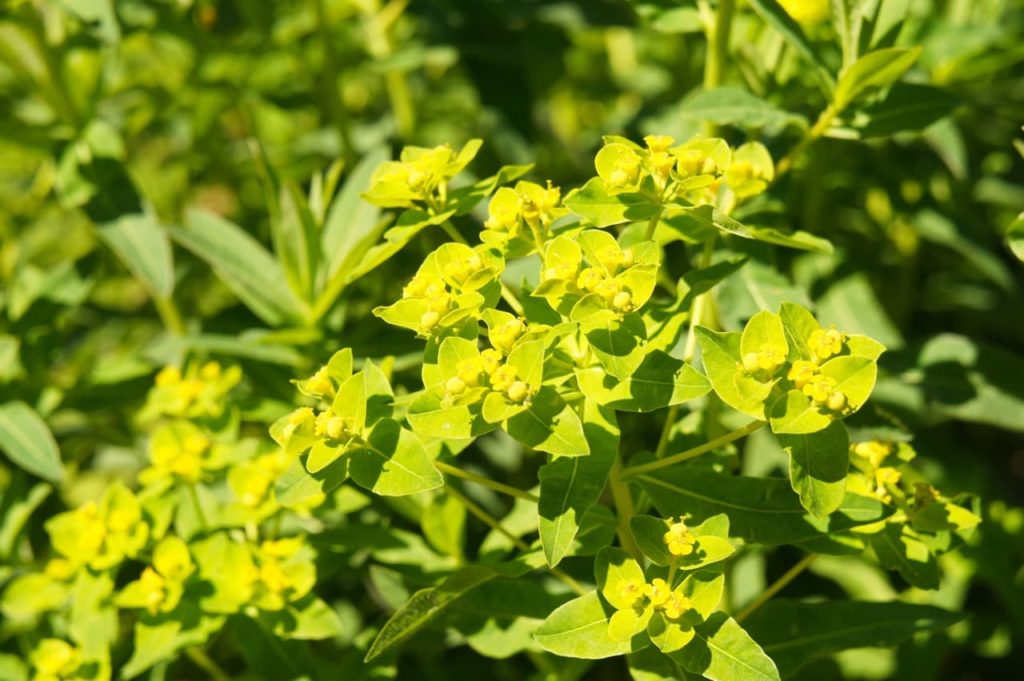
- COMMON NAME(S): Schilling spurge
- HARDINESS RATING: H5
- FOLIAGE: deciduous
- FLOWERING SEASON(S): summer / autumn
- SUNLIGHT: part shade
- SOIL REQUIREMENTS: chalk or sand; any pH
- SIZE: 0.5-1m in height, 0.1-0.5m spread
This is a herbaceous perennial with erect stems that hold green leaves with white veins down their middles and broad clusters of vivid yellow flowers in the summer and into autumn.
These Euphorbias grow best in partial shade in moist but well-drained soil that is rich in organic matter.
14) E. sikkimensis
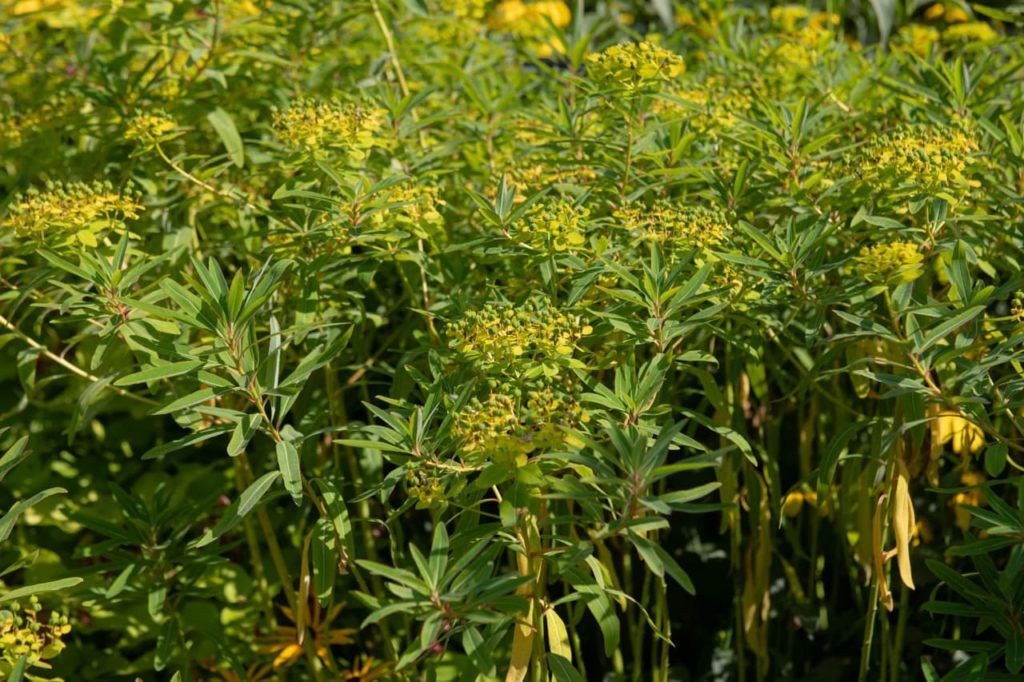
- COMMON NAME(S): Sikkim spurge
- HARDINESS RATING: H5
- FOLIAGE: deciduous
- FLOWERING SEASON(S): summer
- SUNLIGHT: full sun / part shade
- SOIL REQUIREMENTS: all soil types; any pH
- SIZE: 1-1.5m in height, 0.5-1m spread
Sikkim spurge is an upright herbaceous perennial which has narrow leaves on stems that are a pinkish colour when young.
The flowers, borne in loose heads in late summer, are bright yellow in hue.
It needs moist but well-drained soil and is H5 hardy.
There are, of course, many more species besides those listed above and there are also many cultivars of different species to contend with when making your choice.
The above just serves to show how much variety there is in this genus, how many Euphorbias there are to choose from and just how different they can be.

